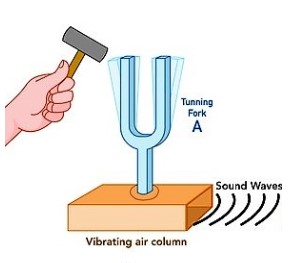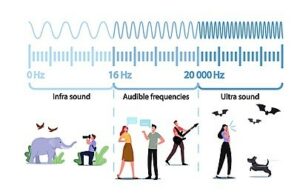The conversion of potential energy to sound energy displays how the stationary particle vibrates after applied force. The article discusses about example of potential energy to sound energy which is listed below:
Read about Potential to Kinetic Energy Examples.
Tuning Fork

The potential energy is converted into kinetic energy when the internal particle’s position alters due to the force. Before striking the tuning fork, it possesses the stored energy, which has the potential to produce sound energy. But when we hit it, it vibrates to cause the sound energy and kinetic energy, which sets its wave-particle to oscillate.

When the wave-particle is at rest, its energy is said to be potential energy, whereas the particles begin oscillating; its energy becomes sound energy. The conversion from potential to sound energy happens only when an object’s surface initiates vibrating due to the various types of force.
Guitar
It is an example of yielding sound energy from potential energy due to the reflection of force. The guitar strings, one of the flexible connectors, are tied from both ends stores the potential energy. When we plucked it, the developed tension force on the string transferred our pull force (pluck) to both ends.

(credit: shutterstocks)
The force is reflecting from both ends of the vibrating string creates sound waves that oscillate to travel through the air in the form of a musical note. The exact principle used on other musical instruments where vibrating strings create sound from potential energy, such as sitar, ukulele, cello, mandolin, harp, etc.
Drum
The sound wave is generated from the drum when we beat on its surface. Initially, the stationary wave particles of the drum’s surface possessed the potential energy. Once we begin hitting the drums, their surface triggers vibrating, which leads to their wave particles ejecting from their fixed position.
The back-and-forth harmonic motion of emitted wave particles leads to the generation of sound energy. The exact principle functions on other musical instruments where vibrating surfaces produce sound from potential energy, such as tabla, gong, banjo, etc.

(credit: shutterstock)
Human Body Organs
It is a typical example that produces sound energy due to muscular body force. The lungs maintain the potential energy in the body, which is squeezed by the throat muscles. The force by throat muscles displaces the air, and it passes through our vocal cords, creating different pitches.
By utilizing mouth organs like the tongue, teeth, palate, we can form different sounds by recreating the sound waves from vocal cords.

(credit: shutterstock)
Flute
It is one of the musical instruments that produce sound energy when we employ the force by buzzing. When we blow the air from our mouth into one end of the flute, the energy that transfers from our mouth excites the stationary particles within the flute. The excited particles oscillate within the flute, producing the sound wave through its holes.
A similar principle functions on other musical instruments where sound is produced by blowing the air from the mouth, such as saxophone, trumpet, clarinet, oboe, harmonica, bassoon, trombone, bagpipes, etc. We can also create higher or lower notes by adjusting the intensity of air blow.
Read about Musical Instruments that its convert potential energy to sound energy when we play it.

(credit: shutterstock)
Rubber Horn
Whenever we press the elastic rubber horn attached to vehicles, the rubber recovers its initial shape due to the elastic force and produces sound from stored potential energy.
Note that the potential energy converted into sound energy in exact amount. That means no energy is lost in the conversion process as per the law of conservation of energy.
Music Speaker
The speaker has a transducer that transforms the amplified signals from the electrical device to the speaker’s coil, where potential energy is stored. The input signals drive the coil to move back or forth along its cone. The back and forth harmonic motion pushes or pulls the air to form pressure waves called sound waves.

The developed sound waves are the air pressure difference that ripples through the air, just like a stone tossed into a lake forms water waves. The sound waves are longitudinal and travel with kinetic energy to reach our ears.
Exploded Balloon
In a closed balloon system, the balloon acquires a large amount of potential energy due to compressed air within. But if we still blow more air into a balloon, the pressure by air stretches the balloon’s wall, and then at one pinpoint, the balloon blasts by making the large sound equivalent to its stored potential energy.
Alarm Clock
It produces sound energy due to compression of the spring, i.e., another flexible connector. As clock needles rotate, the spring gets tight, storing potential energy. But once the needles reach the timing we have set as an alarm, the compressed spring retrieves its earliest shape due to the elastic force that generates the alarm beep sound.
Falling Object into Ground
Any falling objects show the potential energy to kinetic energy conversion. But once it strikes the ground surface, we hear the sound waves. It happens because the ground surface absorbs the kinetic energy of the falling object at the point of impact between two surfaces and then releases the sound we hear.

The identical potential energy to sound energy conversion occurs when we drop any object and when the waterfall naturally reaches the ground.
Toys
Nowadays, we have seen battery-powered toys replace key toys. Hence, instead of springing in key toys, the battery stores the potential energy. When we switch on such toys, they move from one position to another due to converted kinetic energy.
Also, while moving, some toys cause sound or illuminate light from stored potential energy.
Read more about Transverse Waves. Also, please click to read more on 10+ Low Pitch Sound Examples.
Also Read:
- Example of radiant energy
- Example of radiant energy to kinetic energy
- Can electric potential energy be negative
- Gravitational energy examples
- Example of potential energy to thermal energy
- Does gravity affect potential energy
- Does mass affect potential energy
- Types of kinetic energy
- Can potential energy be negative
- Example of radiant energy to electrical energy

Hello, I’m Manish Naik completed my MSc Physics with Solid-State Electronics as a specialization. I have three years of experience in Article Writing on Physics subject. Writing, which aimed to provide accurate information to all readers, from beginners and experts.
In my leisure time, I love to spend my time in nature or visiting historical places.
Looking forward to connecting you through LinkedIn –